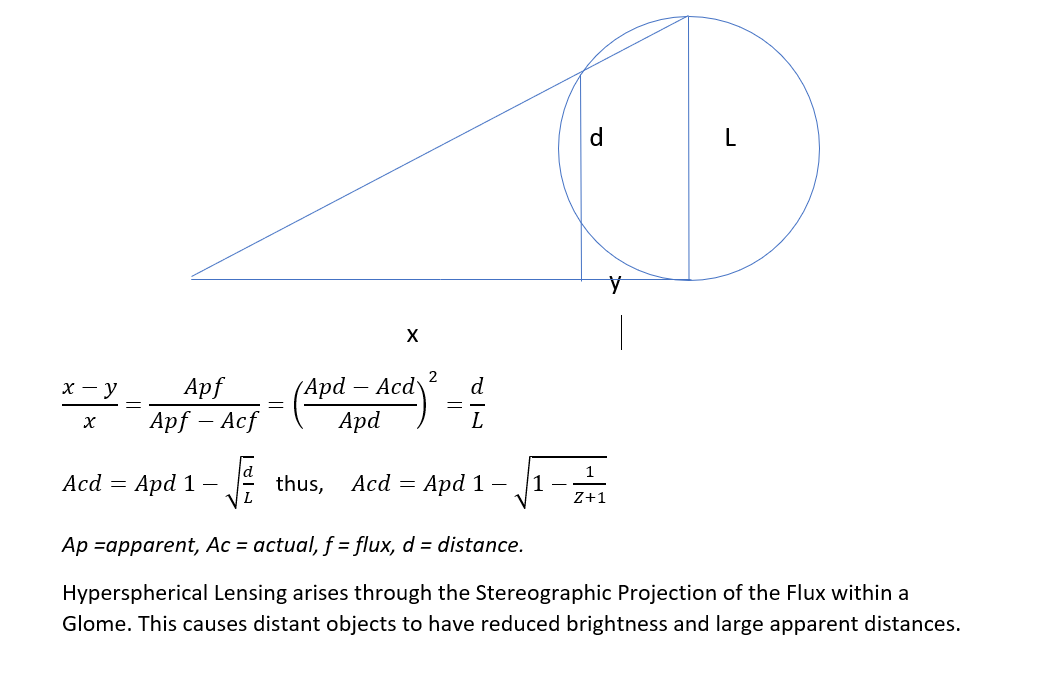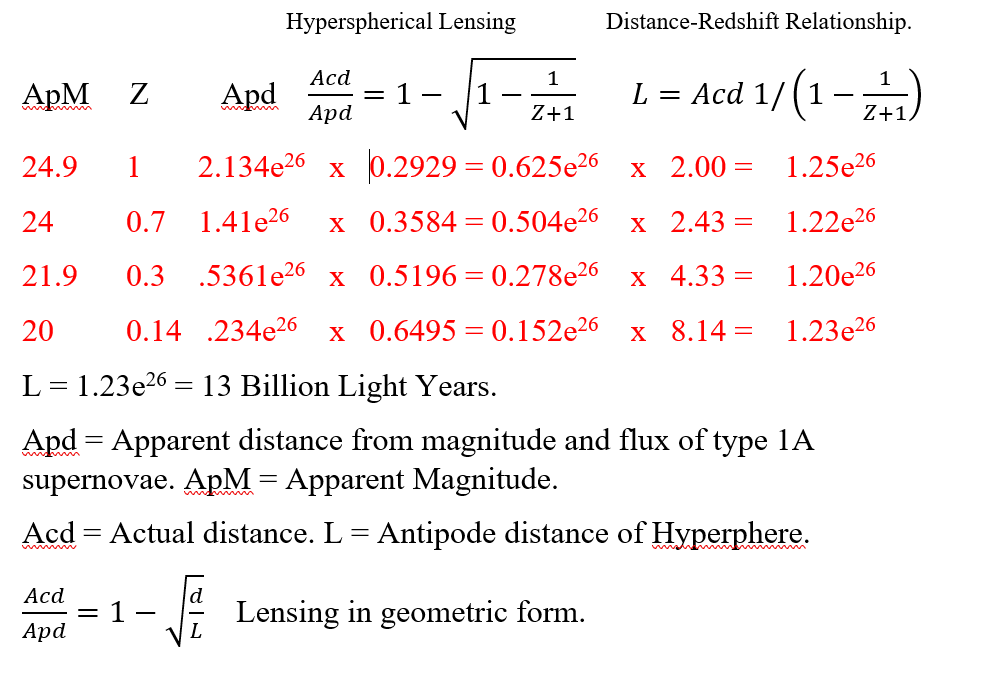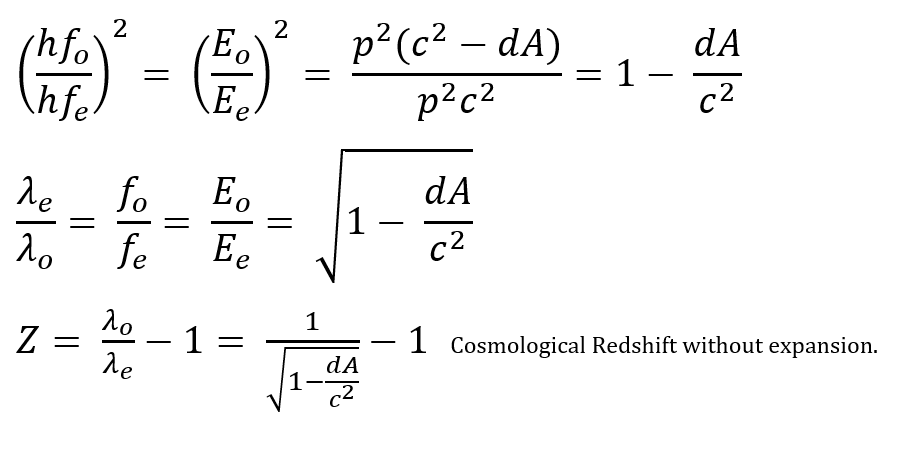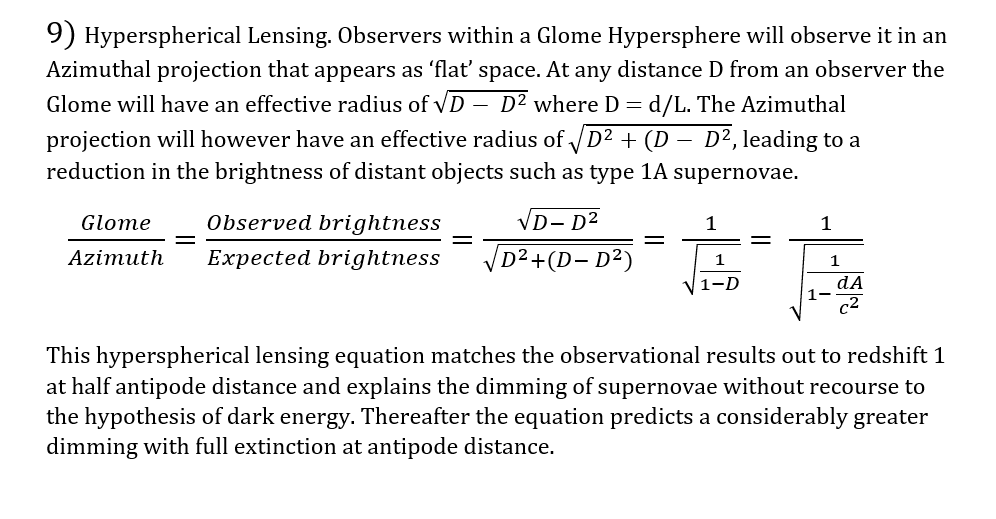Blog
- Details
- Hits: 13080

The above provides the Geometry and Physical Principle for the Algebraic formulation of Hyperspherical Lensing shown in the previous Augblog.
Hypersphere Cosmology seems to evolve towards the exact inverse of the LCDM- BB theory, both seem to fit most of the major observations but in radically different ways. In HC the universe does not expand, rather it explains redshift and brightness decease in terms of a small positive curvature which leads to time dilation and hence a redshift dependant on distance and a lensing effect which dims distant light sources instead of an accelerating expansion driven by dark energy as in LCDM.
In HC the small positive spacetime curvature appears as an acceleration which accounts for the anomalous galactic rotation curves without recourse to dark energy.
HC predicts an antipode which will appear as apparently redshifted and dimmed to unobservability. This contrasts with LCDM which predicts an initial BB singularity of apparently unlimited brightness.
Observations alone may prove insufficient to distinguish between the two models as they both account for the same phenomena, albeit in radically different ways. However, the HC model does contain less Phlogiston, instead of singularity, dark energy and dark matter it has the mechanism of positive spacetime curvature.
The evidence concerning cosmic evolution remains debatable, some of it seems to fit with LCDM-BB, some does not. In particular we seem to observe structures that look far too huge and developed at vast distances for them to have evolved in the early history of expansion. HC asserts that the universe will look broadly homogenous and isotropic at all points in space and time.
- Details
- Hits: 13859

I think we did it. This explains Perlmutter's results without recourse to the hypothesis of Dark Energy. It also gives the correct distances for redshift and it gives the antipode distance.
- Details
- Hits: 13647
JULBLOG.
Politics.
Io Bojo! Boris Johnston becomes our new leader, in our darkest hour for some time.
If we fail to separate this Nation from the EU decisively and soon, we shall become assimilated into the undemocratic bureaucratic EU synarchy forever.
Cometh the hour, cometh the man?
Let us hope so, Boris has studied Churchill and written a book about him.
Boris will need to make some bold strokes fast. A deal with Nigel Farage and a general election in which the conservative constituency parties have deselected all the remain traitors could just alter the parliamentary arithmetic in time for a clean break with the ghastly political project of the EU by Halloween.
Boris, Trump, and Brexit all form part of the great culture war which rages partly in response to globalisation.
For the last few decades the political consensus of the west has moved increasingly towards cultural leftism and economic rightism. Hyper-liberal political correctness and economic inequality have grown to offensive levels and the peasants have started to revolt.
The fightback to a rather more cultural rightness and a rather more economic leftness has begun. It won’t go as far as full National Socialism unless it becomes thwarted.
Your average Revolting Peasant in the west wants less multiculturism and more effort expended on its own culture. It doesn’t want LGBT behaviour actively promoted as normal and acceptable to its schoolchildren. It doesn’t want the absurdities of political correctness enforced by law and punishment.
Your average Revolting Peasant in the west doesn’t want the deregulated capitalism that outsources its manufacturing to the lowest bidder, migrant or third world, and then offers downmarket service work instead of proper employment.
Your average Revolting Peasant would prefer to celebrate the history of the Nation rather than have liberal cultural lefties continually try to find the worst in it to recruit supporters through a sense of fake victimhood.
The UK Labour and Illiberal Dimocrat parties seem dominated by a clique of cultural ultra-leftists. The UK Conservative party still nurses too many vested interests in deregulated capitalism.
At the Brexit vote more than half the electorate basically said this country has become fairly shite and we don’t like the way it’s going.
With Brexit we can Make Britain Pretty Good Again.
Physics. Corrections and updates to Hypersphere Cosmology: -
GM/L2 = c2/2L = A/2. v2 = 2dA/2 = dA. In the Pioneer Anomaly, measured decelleration = A/2.
p - photon momentum.

HC now becomes fully compatible with both SR and GR. The effects of Acceleration and Gravity become exactly Equivalent.
Magic.

Retirement from trading has brought me time and leisure, so I thought to fashion the ultimate swiss-army multitool of a magical instrument:
Herewith the Mk127 Purba. Pearwood grown in my own gardens (sadly the wind took the tree over a while ago). Sigils of the Elder Gods on one end, Sigils of the Eight Colours of Magic in the middle, Sigils of the conjurations of Enchantment, Divination, Evocation, and Invocation on the other, Chaos Star to follow.
- Details
- Hits: 13197
Some recent correspondences seem to have led to some thoughts perhaps worth noting for posterity in an extended ramble: -
Hippy or Punk?
I spent my formative years on the late hippy scene, 1974-1980. Subcultural trends in the UK tended to run on social class, the hippies mostly came from the upper middle and middle classes (I came from the upper working class but going to university promoted me to lower middle class). Hippy-ism had a strong mystical component and a relaxed attitude to material success because the economy had plenty of slack in it at the time. The Punk movement came later, mostly from the upper working class and the middle working class, and it seemed angrier and more violent, partly because of social and political conditions at the time, views had become polarised and economic life had become more competitive. Thank Margaret Thatcher.
The antinomianism of Chaos Magic did attract a fair bit of interest from the Punk generation, though - they liked its rebelliousness.
Looking back, I now realise that the part of traditional occultism I rejected in forging Chaos Magic comes down to one main thing - Neoplatonism, and I rejected that because of my scientific education. I don't find the theory of earth, air, fire, and water useful, and I don't believe that gods and entities exist independently of the human mind, however I do believe in the psychological and parapsychological power of intent and imagination. Thus, we can make gods and demons to assist and serve us. I attempted to supplant the Neoplatonic-Pagan-Monotheism which had underpinned occult thinking for two millennia with a Quantum-Neo-Paganism.
Chaos magic also developed by defining itself as against Crowley and Thelema. We can do better I proclaimed, (but few of them did).
I would agree with the observation, that you need to keep your feet on the ground with a well-crafted Solar persona whilst pursuing the Ouranian quest. I never gave up on the day career and 'normal' life; or on the weird quest either. I think that benefited both.
Conservative or Radical?
The enlightenment and radicalism of the age become the oppression and conservatism of the next age.
Now history happens so fast, and people live so long, that this can happen twice in a single lifetime.
(Social liberalism and political correctness went toxic and authoritarian in my own lifetime, vociferous minorities now seem to set the culture war agenda.)
They used to say that human progress happens one funeral at a time.
Today your ideas can die before you do.
Consequently, I have given up following fashions in ideas and in science, art, and morality.
Does that make me a conservative or a radical?
‘Orthodox Chaoism’ now dominates all magical thinking in the westernised world, its influence seems pervasive, the remaining pockets of Neoplatonism seem untenable. I don’t deserve all the credit for this, I saw the way the wind blew and simply hoisted more sail and puffed into it. I don’t feel the need to promote or defend Chaos Magic further although I use it constantly. According to Aeonic Theory it will remain the prime esoteric paradigm until something of a yet barely imagined transcendentalist way of thinking supersedes it. (Some form of mystical ecology might do just that.)
For the remaining part of this incarnation I have two esoteric quests, to replace the conventional cosmological model of a big-bang origin for this universe with something more credible that better fits the unadulterated observational data (like Hypersphere Cosmology, in progress), and also to make some sense of the quantum and particle domain underlying reality, using perhaps 3D time (progress slow, I may not live long enough to finish this).
I find the apocalypticism of the current scientific creation myth as metaphysically unsatisfactory as the apparent lack of an underlying reality in the quantum domain.
I seem to have become an esoteric conservative and a scientific radical, with leanings towards social conservatism as I observe the increasing social decay in my environment. Whilst the upper echelons and intelligentsia of western societies could usually cope with some indulgences in recreational sex and drugs, the effect on the lower orders and the ignorati appears increasingly catastrophic.
Racist or Culturalist?
Humans tend to adopt the culture that nurtures them because our high intelligence also brings with it a hyper-suggestibility. We tend to end up believing what we do rather than doing what we believe. Politicians and priests have always known this, make people do something or make people use some form of thought-speak and their beliefs will follow sheepishly behind.
Personally, I do make value judgements about cultures; some religions and polities do seem to spawn quite ghastly, ignorant, and inhuman behaviour, irrespective of the ethnicities involved.
So does the following assertion count as racist or culturalist?
Yes, I have encountered many people who find working for German bosses odious - one of the reasons I think we should exit the EU before we all end up working for them!
Alternative Physics.
The further we investigate the recent history of cosmology the more apparent it becomes that the baroque mess of the currently dominant Lambda-CDM model has its roots in assumptions made back around AD 1930. Today it has become difficult to even find observational data that hasn’t undergone deformation by the expansion hypothesis before presentation.
A extract of Hypersphere Cosmology in progress follows, Section 9 which shows an upgrade to the hyperspherical lensing which eliminates dark energy (Lambda).

- Details
- Hits: 11913
Some recent correspondences seem to have led to some thoughts perhaps worth noting for posterity in an extended ramble: -
Hippy or Punk?
I spent my formative years on the late hippy scene, 1974-1980. Subcultural trends in the UK tended to run on social class, the hippies mostly came from the upper middle and middle classes (I came from the upper working class but going to university promoted me to lower middle class). Hippy-ism had a strong mystical component and a relaxed attitude to material success because the economy had plenty of slack in it at the time. The Punk movement came later, mostly from the upper working class and the middle working class, and it seemed angrier and more violent, partly because of social and political conditions at the time, views had become polarised and economic life had become more competitive. Thank Margaret Thatcher.
The antinomianism of Chaos Magic did attract a fair bit of interest from the Punk generation, though - they liked its rebelliousness.
Looking back, I now realise that the part of traditional occultism I rejected in forging Chaos Magic comes down to one main thing - Neoplatonism, and I rejected that because of my scientific education. I don't find the theory of earth, air, fire, and water useful, and I don't believe that gods and entities exist independently of the human mind, however I do believe in the psychological and parapsychological power of intent and imagination. Thus, we can make gods and demons to assist and serve us. I attempted to supplant the Neoplatonic-Pagan-Monotheism which had underpinned occult thinking for two millennia with a Quantum-Neo-Paganism.
Chaos magic also developed by defining itself as against Crowley and Thelema. We can do better I proclaimed, (but few of them did).
I would agree with the observation, that you need to keep your feet on the ground with a well-crafted Solar persona whilst pursuing the Ouranian quest. I never gave up on the day career and 'normal' life; or on the weird quest either. I think that benefited both.
Conservative or Radical?
The enlightenment and radicalism of the age become the oppression and conservatism of the next age.
Now history happens so fast, and people live so long, that this can happen twice in a single lifetime.
(Social liberalism and political correctness went toxic and authoritarian in my own lifetime, vociferous minorities now seem to set the culture war agenda.)
They used to say that human progress happens one funeral at a time.
Today your ideas can die before you do.
Consequently, I have given up following fashions in ideas and in science, art, and morality.
Does that make me a conservative or a radical?
‘Orthodox Chaoism’ now dominates all magical thinking in the westernised world, its influence seems pervasive, the remaining pockets of Neoplatonism seem untenable. I don’t deserve all the credit for this, I saw the way the wind blew and simply hoisted more sail and puffed into it. I don’t feel the need to promote or defend Chaos Magic further although I use it constantly. According to Aeonic Theory it will remain the prime esoteric paradigm until something of a yet barely imagined transcendentalist way of thinking supersedes it. (Some form of mystical ecology might do just that.)
For the remaining part of this incarnation I have two esoteric quests, to replace the conventional cosmological model of a big-bang origin for this universe with something more credible that better fits the unadulterated observational data (like Hypersphere Cosmology, in progress), and also to make some sense of the quantum and particle domain underlying reality, using perhaps 3D time (progress slow, I may not live long enough to finish this).
I find the apocalypticism of the current scientific creation myth as metaphysically unsatisfactory as the apparent lack of an underlying reality in the quantum domain.
I seem to have become an esoteric conservative and a scientific radical, with leanings towards social conservatism as I observe the increasing social decay in my environment. Whilst the upper echelons and intelligentsia of western societies could usually cope with some indulgences in recreational sex and drugs, the effect on the lower orders and the ignorati appears increasingly catastrophic.
Racist or Culturalist?
Humans tend to adopt the culture that nurtures them because our high intelligence also brings with it a hyper-suggestibility. We tend to end up believing what we do rather than doing what we believe. Politicians and priests have always known this, make people do something or make people use some form of thought-speak and their beliefs will follow sheepishly behind.
Personally, I do make value judgements about cultures; some religions and polities do seem to spawn quite ghastly, ignorant, and inhuman behaviour, irrespective of the ethnicities involved.
So does the following assertion count as racist or culturalist?
Yes, I have encountered many people who find working for German bosses odious - one of the reasons I think we should exit the EU before we all end up working for them!
Alternative Physics.
The further we investigate the recent history of cosmology the more apparent it becomes that the baroque mess of the currently dominant Lambda-CDM model has its roots in assumptions made back around AD 1930. Today it has become difficult to even find observational data that hasn’t undergone deformation by the expansion hypothesis before presentation.
A extract of Hypersphere Cosmology in progress follows, Section 9 which shows an upgrade to the hyperspherical lensing which eliminates dark energy (Lambda).
